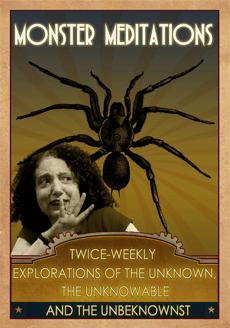Some monsters are brutes — formidable muscles with very little in the brain department. They are fearsome creatures because they cannot reason. Like a hungry shark, they are all appetite and no manners. Their thinking is straight ahead — hunt, kill, eat, sleep and repeat.
Monsters with minds are much scarier. A brute cannot plan more than a few moves into the future, a monster with a powerful brain and no moral compass is often one step ahead of a human. We are easily distracted. Love, lust, greed, ambition, and everything else under the sun, pull and push us in different directions.
Stories with brutish monsters seem to require monster hunters with divided loyalties, complicated romantic entanglements or other major distractions — while stories featuring brainy evil creatures the monster can be paired with less complicated heroes.
Of course the best monster stories have a matched pair — a clever beast and an equally smart heroic figure. Sherlock Holmes and Moriarty — in the original stories, classic films and current TV incarnations — are a perfectly matched pair. I recently read an article delineating just how far on the scale of psychopathology Sherlock sits. (Probably right next to his nemesis.) The Vampire Count and the good doctor, Van Helsing, are a matched pair in the original Bram Stoker tale, but in many retellings of the classic, things get out of balance.
Dr. Frankenstein and his creation are a team that inspires a wide range of stories and in the best versions it’s very hard to tell the monster from the “good” man. I’m a fan of Mary Shelley’s story. If you’ve never read it, you’ll be surprised by the ambivalence about good and evil. It may not have been Mary Shelley’s intention, but more often than not, I found myself on the brainy monster’s side.





I do like the Frankenstein story. But in the original much like many of the writers of the time, I found her writings a bit too flowery for me. But at the same time I really loved Dracula.
I remember from the Doc Savage stories I read growing up, when they introduced a moriarty like villain by the name Johnny Sunlight. Basically a man who was the intellectual equal to the Doc. Made for some good reading even for something that was pure pulp.
Pure pulp has its place! Some people might consider it a guilty pleasure, but not me.
Yes, Mary Shelley and Bram Stoker write in styles that are flowery to 21st century readers, but they are worthwhile reading.
I’ve often wondered about the transformation of Mary’s monsters — a monster who is horribly ugly and terrifically intelligent — morphed into the lumbering figure in the Universal Pictures classic films. The blind man in the book, and in the video of a British theatrical production I saw a couple of years ago, teaches the monster to read and he has a beautiful mind. It’s only when people reject him, because of his appearance, that he becomes enraged and sets out on his murderous adventures. Mary made a brainy monster, but Hollywood made him a brute.
Of course the Mel Brooks incarnation is one of my favorite movies of all time and that monster has it all!
Thinking monsters are the best. Shelley’s story strikes me as quite concise and the development of her monster much more well-rounded than Stoker’s. Once I get my mind ready for their style of writing, it’s a great place to hang out for awhile. I wasn’t lucky enough to ever get to teach Frankenstein, but my colleague really got into it since as you point out how ambivalent the story is regarding good and evil. The monsters that the literary classic monsters have beget are run the gambit too–Frankenweenie, anyone?
Teaching Frankenstein would have been an amazing experience. Just discussing the monster’s relationship with the blind man OR his desire to have a wife — and the terrible actions that desire leads to — would have been very exciting. Especially when the students were familiar with Frankenweenie and the movies that turn the monster into a non-thinking hulk.
Now we use “Frankenstein” to refer to any and all outlier science, anything that might form a mash-up of human and non-human and that covers a great deal of territory. Mary Shelley didn’t know what she started!
Human nature is such a mixed bag of nasty and nice, it’s not really that surprising we project one side or the other on our ‘monsters’ and ‘heroes’. Or perhaps it harks back to the old religious concepts of good and evil – man’s soul is good, while the baser emotions are supposed to be linked to the animal flesh.
As far as I’m concerned, give me a great villain any day, at least in fiction. 😉
The villain is often the more interesting of the two. I think that’s why the Greeks gave their heroes flaws. The perfect hero is just too dull.
As for the classic good/evil divide, when I read “The Strange Case of Dr. Jekyll and Mr. Hyde” I was struck by the pre- Freudian ideas about human nature. Now, I think most people will acknowledge that our drives, our ambitions, our passions and even our desires, can go toward a “good” or “evil” objective, but that we are, with notable exceptions, neither saints nor devils.
That’s why I couldn’t write a straight out updating of the classic. I had to reinterpret the values of what is good and what’s bad, in a context and time when nearly everything is floating in the gray area.